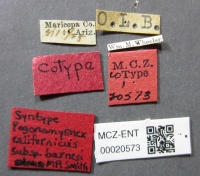Pogonomyrmex californicus
| Pogonomyrmex californicus | |
|---|---|
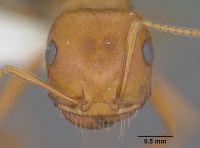
| |
| Scientific classification | |
| Kingdom: | Animalia |
| Phylum: | Arthropoda |
| Class: | Insecta |
| Order: | Hymenoptera |
| Family: | Formicidae |
| Subfamily: | Myrmicinae |
| Tribe: | Pogonomyrmecini |
| Genus: | Pogonomyrmex |
| Species group: | californicus |
| Species: | P. californicus |
| Binomial name | |
| Pogonomyrmex californicus (Buckley, 1867) | |
| Synonyms | |
| |
| Common Name | |
|---|---|
| California Harvester Ant | |
| Language: | English |
The nest of Pogonomyrmex californicus is surmounted by a circular or semicircular crater of loose sand bearing a single entrance.
| At a Glance | • Facultatively polygynous |
Identification
Cole (1968) - Identification of workers of the "typical" Pogonomyrmex californicus has apparently presented no problems. Such workers are those which comprise that part of the over-all population chiefly in coastal California and Baja California. They are of comparatively small stature and bear coarse cephalic and thoracic rugae, the interspaces of which are strongly shining and faintly or not at all punctate. The petiolar node is short and rather broad, and it has a prominent nipple and a steep anterior declivity. The body is a concolorous, rather light, ferrugineous red.
With eastward progression in the range of californicus, however, the following clinal transitions and tendencies can be noted in the worker caste: (1) decrease in number, spacing, and coarseness of cephalic rugae; (2) addition of interrugal punctures on the head and pronotal humeri; (3) decrease in gradient of the anterior declivity of the petiolar node; (4) development of a more spatulate petiolar node, the sides becoming more convex; (5) reduction of the petiolar nipple; (6) tendency toward the development of a ventral petiolar peduncular process; (7) lengthening of both petiolar and postpetiolar nodes; (8) reduction in size of the postpetiolar ventral process; (9) increase in over-all size; and (10) infuscation of the gaster in some or all of a series, from lateral spotting to concolorous black or brown.
Keys including this Species
Distribution
United States: Western Texas, southern New Mexico, southern Utah, Arizona, western Nevada, southern California. Mexico: Baja California, Sonora, Chihuahua.
Latitudinal Distribution Pattern
Latitudinal Range: 41.257609° to 19.134331°.
| North Temperate |
North Subtropical |
Tropical | South Subtropical |
South Temperate |
- Source: AntMaps
Distribution based on Regional Taxon Lists
Nearctic Region: United States (type locality).
Neotropical Region: Mexico.
Distribution based on AntMaps
Distribution based on AntWeb specimens
Check data from AntWeb
Countries Occupied
| Number of countries occupied by this species based on AntWiki Regional Taxon Lists. In general, fewer countries occupied indicates a narrower range, while more countries indicates a more widespread species. |

|
Habitat
Nearly all arid environments ranging from weedy bajadas to grasslands on to creosotebush scrub.
Abundance
Can be locally abundant; common in northern Mexico.
Biology
Typically nests in sandy soils where it has small mounds (20 cm diameter). This species does not clear vegetation surrounding the nest. Nest populations are about 2000 individuals, with a nest depth of 2 meters. It is primarily a seed harvester. Foragers are often active during relatively hot times of the day, during which the ants run stiff-legged with the gaster elevated, apparently in an attempt to distance themselves from the hot surface. They can often be seen mounting small pebbles and stones and waving their legs, apparently attempting to lower their body temperatures. It is very pugnacious and is one of the two ants in New Mexico with the most painful sting (the other species is Pogonomyrmex maricopa). The sting is barbed and becomes detached to remain in the flesh, as occurs in the honeybee. It is possible to watch the sting apparatus apparently pump venom into one’s tissues, especially through a microscope. Reproductives are found in nests from May to July. Flights occur from May to July and a single nest may participate in several nuptial flights. Horned lizards (Phrynosoma spp.) are major predators. (Mackay and Mackay 2002)
The workers are assiduous harvesters; they forage all day, except during the hottest hours. Seeds are harvested in great numbers, notably those of Phacelia spp., Aristida sp., and Sarcobatus vermiculatus; the mounds are often surrounded by the bracts of these and other seeds (Cole, 1932b: 115).
In Nevada, Wheeler and Wheeler (1986): This red or red and black harvester is one of the common ants of the Mojave and Sonoran deserts. We have found chambers at a depth of 2 l/2 cm under an area of 30-60 cm2; these usually contained seeds or chaff. In a flourishing colony we found brood, seeds, and sexual forms in the same chamber, with the brood lying on the seeds. We also found stored seeds at a depth of 7 l/2 cm. The workers ran rapidly and erratically, with frequent stops and changes of direction for no apparent reason. Often the gaster was conspicuously elevated; this doubtless had a cooling function. The nest was closed with sand or pebbles at night and in the heat of the day. We have a total of 261 records from 175 localities; 500-6,300 ft.: 28 from the Hot Desert, 83 from the Cool Desert (45 from Sarcobatus Subclimax, 2 from cottonwood groves, 17 from disturbed areas, and 13 from sand dunes). In Nevada P. califomicus is common and widely distributed in the southern and western portions of the state. We have no records from a zone 40 mi. wide along the entire northern border and no records from Elko, White Pine, and Lander counties. We found the following myrmecophilous beetles in the nests: Araeoschizus armatus; Araeoschisuz armatus and Notibus nr puncticollis LeC; Notibus puberulus LeC; Notibus substriatus Casey; Papusus sp. probably macer Casey.
Flight Period
| X | X | X | X | X | |||||||
| Jan | Feb | Mar | Apr | May | Jun | Jul | Aug | Sep | Oct | Nov | Dec |
Source: antkeeping.info.
- Check details at Worldwide Ant Nuptial Flights Data, AntNupTracker and AntKeeping.
 Explore: Show all Flight Month data or Search these data. See also a list of all data tables or learn how data is managed.
Explore: Show all Flight Month data or Search these data. See also a list of all data tables or learn how data is managed.
Life History Traits
- Mean colony size: 4,500 (Holldobler & Wilson, 1970; Erickson, 1972; Beckers et al., 1989)
- Foraging behaviour: mass recruiter (Holldobler & Wilson, 1970; Erickson, 1972; Beckers et al., 1989)
Castes
Worker
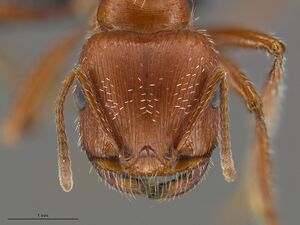 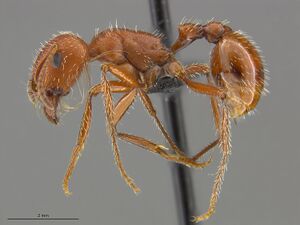  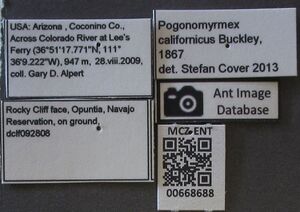
| |
| Worker. . | Owned by Museum of Comparative Zoology. |
Images from AntWeb
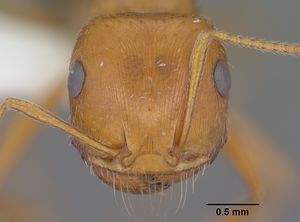   
| |
| Worker. Specimen code casent0102895. Photographer Jen Fogarty, uploaded by California Academy of Sciences. | Owned by CAS, San Francisco, CA, USA. |
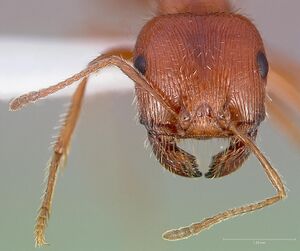 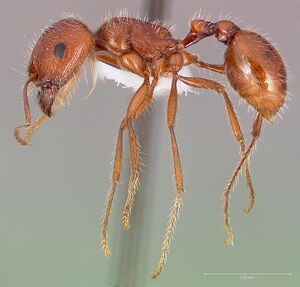 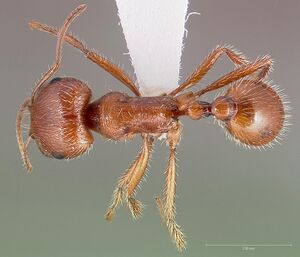 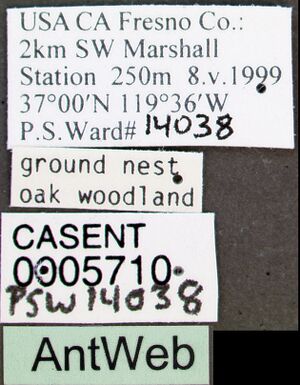
| |
| Worker. Specimen code casent0005710. Photographer April Nobile, uploaded by California Academy of Sciences. | Owned by UCDC, Davis, CA, USA. |
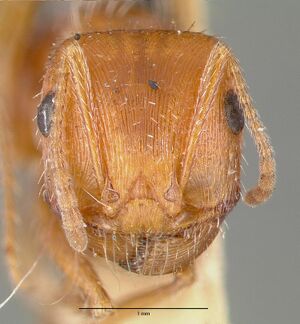   
| |
| Syntype of Pogonomyrmex badius estebanius. Worker. Specimen code castype00626. Photographer April Nobile, uploaded by California Academy of Sciences. | Owned by CAS, San Francisco, CA, USA. |
Queen
Images from AntWeb
 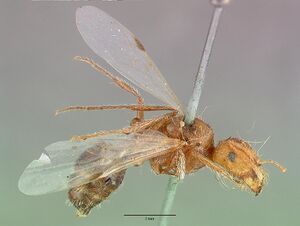 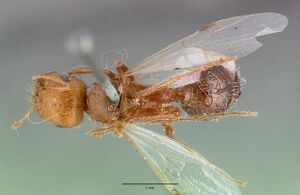 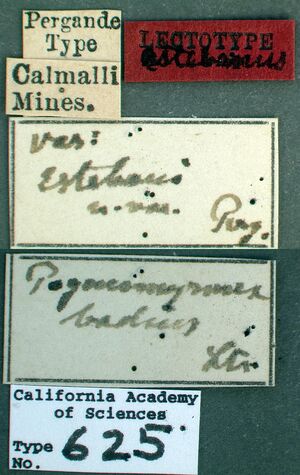
| |
| Lectotype of Pogonomyrmex badius estebanius. Queen (alate/dealate). Specimen code castype00625. Photographer April Nobile, uploaded by California Academy of Sciences. | Owned by CAS, San Francisco, CA, USA. |
Nomenclature
The following information is derived from Barry Bolton's Online Catalogue of the Ants of the World.
- californicus. Myrmica californica Buckley, 1867: 336 (w.) U.S.A. Wheeler, W.M. 1914e: 153 (q.m.); Taber, Cokendolpher & Francke, 1988: 51 (k.). Combination in Pogonomyrmex: Emery, 1895c: 311. Senior synonym of estebanius, longinodis, nitratus: Cole, 1968: 120; of hindleyi: Snelling, R.R. 1982a: 98. See also: Tulloch, 1930: 61.
- estebanius. Pogonomyrmex badius subsp. estebanius Pergande, 1893: 33 (w.q.) MEXICO. Wheeler, W.M. 1914e: 154 (m.). Subspecies of californicus: Emery, 1895c: 311; Wheeler, W.M. 1902c: 391. Junior synonym of californicus: Cole, 1968: 120.
- longinodis. Pogonomyrmex californicus subsp. longinodis Emery, 1895c: 311 (w.) U.S.A. Raised to species: Creighton, 1950a: 126. Junior synonym of californicus: Cole, 1968: 120.
- hindleyi. Pogonomyrmex californius var. hindleyi Forel, 1914d: 270 (w.) U.S.A. Raised to species: Creighton, 1950a: 125. Junior synonym of californicus: Snelling, R.R. 1982a: 98.
- nitratus. Pogonomyrmex californicus subsp. nitratus Cook, 1953: 99, fig. (w.) U.S.A. Junior synonym of californicus: Cole, 1968: 121.
Unless otherwise noted the text for the remainder of this section is reported from the publication that includes the original description.
Description
Worker
Cole (1968) - HL 1.43-1.92 mm, HW 1.39-1.99 mm, CI 92.8-103.6, SL 1.10-1.53 mm, SI 69.9-97.4, EL 0.27-0.46 mm, EW 0.22-0.34 mm, OI 18.2-24.0, WL 1.20-2.57 mm, PNL 0.31-0.63 mm, PNW 0.34-0.56 mm, PPL 0.34-0.56 mm, PPW 0.42-0.75 mm.
Mandible as illustrated in Pl. III, Fig. 9. Base of antennal scape as shown in Pl. IV. Fig. 9; contour of thorax, petiole, and postpetiole, in lateral view, as in Pl. VI, Fig. 8.
Cephalic sculpture varying from a few, coarse, widely spaced rugae with or without sparse interrugal punctures to notably more abundant, more closely spaced rugae and dense, fine, interrugal punctures. Interrugal spaces of head and thorax distinctly shining. Interrugal spaces of thorax, except sides of epinotum, with or without punctures; those of sides of epinotum without punctures. Epinotum unarmed, the angle between the epinotal base and declivity generally smooth and broadly rounded but sometimes rather sharp. Contour of petiolar and postpetiolar nodes, in dorsal view, as shown in Pl. VII, Figs. 12, 13. Petiolar and postpetiolar nodes with or without irregular rugae or striae.
Color variable as follows: concolorous light or medium ferrugineous red; concolorous ferrugineous red except gaster which bears lateral blotches of black or a black apical portion; head and thorax ferrugineous red, petiole and postpetiole red or brown, and gaster brown or black.
Queen
Cole (1968) - HL 1.53-1.80 mm, HW 1.48-1.84 mm, CI 94.8-102.2, 5L 1.11-1.22 mm, SI 66.3-75.0, EL 0.34-0.43 mm, EW 0.24-0.29 mm, OI 20.9-23.9, WL 2.19-2.36 mm, PNL 0.39-0.18 mm, PNW 0.43-0.51 mm, PPL 0.44-0.53 mm, PPW 0.65-0.78 mm.
With the usual female characters and those of the worker, except interrugal spaces of head very smooth and shining and without any definite interrugal sculpture.
Male
Cole (1968) - HL 1.19-l.48 mm, HW 1.36-1.60 mm, CI 105.1-114.3, SL 0.66-0.73 mm SI 45.6-52.2, EL 0.48-0.56 mm, EW 0.29-0.36 mm, OI 37.5-42.9, WL 2.35-249 mm, PNL 0.36-0.44 mm, PNW 0.53-0.70 mm, PPL 0.51-0.70 mm, PPW 0.77-0.97 mm.
Head with a distinct, though sometimes weak, median longitudinal carinula across the occiput and vertex; mandible as shown in Pl. VIII, Fig. 8, blade moderately bent, bearing 2 to 4 (usually 2 or 3) teeth on a narrow, transverse, generally somewhat constricted, apical margin. Anterior declivity of pronotum, in lateral view, meeting the short pronotal collar at an abrupt angle. Epinotum without armature. Petiolar node, viewed from above, approximately as broad as long, the sides broadly convex. Sculpture of body not definitive. Paramere as shown in Pl. X, Fig. 7 and Pl. XI, Fig 7.
Karyotype
- See additional details at the Ant Chromosome Database.
 Explore: Show all Karyotype data or Search these data. See also a list of all data tables or learn how data is managed.
Explore: Show all Karyotype data or Search these data. See also a list of all data tables or learn how data is managed.
- 2n = 32 (USA) (Taber et al., 1988) (as P. estebanius).
References
- Ahmad, T., Haile, A., Gebremeskel, H., Mekonnen, S. 2012. Reduction of seed harvester ants, Pogonomyrmex spp. (Hymenoptera: Formicidae), damages by using some insecticides. African Journal of Agricultural Research 7, 5680–5684 (doi:10.5897/ajar12.649).
- Alatorre-Bracamontes, C.E., Vásquez-Bolaños, M. 2010. Lista comentada de las hormigas (Hymenoptera: Formicidae) del norte de México. Dugesiana 17(1): 9-36.
- Baer, B. 2011. The copulation biology of ants (Hymenoptera: Formicidae). Myrmecological News 14: 55-68.
- Baty, J.W., Bulgarella, M., Dobelmann, J., Felden, A., Lester, P.J. 2020. Viruses and their effects in ants (Hymenoptera: Formicidae). Myrmecological News 30: 213-228 (doi:10.25849/MYRMECOL.NEWS_030:213).
- Beckers R., Goss, S., Deneubourg, J.L., Pasteels, J.M. 1989. Colony size, communication and ant foraging Strategy. Psyche 96: 239-256 (doi:10.1155/1989/94279).
- Bespalova, I. 2020. Coordinating individual behavior in collective processes; Seed choice in Harvester Ants (Pogonomyrmex californicus) (unpublished Ph.D. thesis, summary).
- Boulay, R., Galarza, J. et al. 2010. Intraspecific competition affects population size and resource allocation in an ant dispersing by colony fission. Ecology, 91(11), 3312–3321.
- Brown, M.J.F., Bonhoeffer, S. 2003. On the evolution of claustral colony founding in ants. Evolutionary Ecology Research 5: 305–313.
- Buckley, S. B. 1867. Descriptions of new species of North American Formicidae (continued from page 172.). Proc. Entomol. Soc. Phila. 6: 335-350 (page 336, worker described)
- Choe, J.C. 2010. Colony founding in social insects. Encyclopedia of Animal Behavior (Second Edition), pp. 310-316.
- Cole, A. C., Jr. 1968. Pogonomyrmex harvester ants. A study of the genus in North America. Knoxville, Tenn.: University of Tennessee Press, x + 222 pp. (page 120, Senior synonym of estebanius, longinodis and nitratus)
- Emery, C. 1895d. Beiträge zur Kenntniss der nordamerikanischen Ameisenfauna. (Schluss). Zool. Jahrb. Abt. Syst. Geogr. Biol. Tiere 8: 257-360 (page 311, Combination in Pogonomyrmex)
- Gospocic, J., Glastad, K.M., Sheng, L., Shields, E.J., Berger, S.L., Bonasio, R. 2021. Kr-h1 maintains distinct caste-specific neurotranscriptomes in response to socially regulated hormones. Cell 184, 5807–5823.e14 (doi:10.1016/j.cell.2021.10.006).
- Groark, K.P. 1996. Ritual and therapeutic use of "hallucinogenic" harvester ants (Pogonomyrmex) in native south-central California. Journal of Ethnobiology 16, 129.
- Groark, K.P. 2001. Taxonomic identity of hallucinogenic harvester ants (Pogonomyrmex californicus) confirmed. Journal of Ethnobiology 21, 133-144.
- Mackay, W. P. and E. Mackay. 2002. The ants of New Mexico (Hymenoptera: Formicidae). Edwin Mellen Press, Lewiston, NY.
- Matte, A., Billen, J. 2012. Flight muscle histolysis in Lasius niger queens. Asian myrmecology 13, e013003 (doi:10.20362/am.013003).
- Moura, M.N., Cardoso, D.C., Cristiano, M.P. 2020. The tight genome size of ants: diversity and evolution under ancestral state reconstruction and base composition. Zoological Journal of the Linnean Society, zlaa135 (doi:10.1093/zoolinnean/zlaa135).
- Parker, J.D., Rissing, S.W. 2002. Molecular evidence for the origin of workerless social parasites in the ant genus Pogonomyrmex. Evolution 56: 2017-2028.
- Paul, J., Gronenberg, W. 2002. Motor control of the mandible closer muscle in ants. Journal of Insect Physiology 48, 255–267 (doi:10.1016/s0022-1910(01)00171-8).
- Pirk, G.I., Casenave, J.L.de 2006. Diet and seed removal rates by the harvester ants Pogonomyrmex rastratus and Pogonomyrmex pronotalis in the central Monte desert, Argentina. Insectes Sociaux 53, 119–125 (doi:10.1007/s00040-005-0845-6).
- Reznikova, Z. 2020. Spatial cognition in the context of foraging styles and information transfer in ants. Animal Cognition. (doi:10.1007/s10071-020-01423-x).
- Ruano, F., Tinaut, A., Soler, J.J. 2000. High surface temperatures select for individual foraging in ants. Behavioral Ecology 11, 396-404.
- Ślipiński, P., Trigos-Peral, G., Maák, I., Wojciechowska, I., Witek, M. 2021. The influence of age and development temperature on the temperature-related foraging risk of Formica cinerea ants. Behavioral Ecology and Sociobiology 75, 107 (doi:10.1007/s00265-021-03029-w).
- Snelling, R. R. 1982a [1981]. The taxonomy and distribution of some North American Pogonomyrmex and descriptions of two new species (Hymenoptera: Formicidae). Bull. South. Calif. Acad. Sci. 80: 97-112 (page 98, Senior synonym of hindleyi)
- Taber, S. W.; Cokendolpher, J. C.; Francke, O. F. 1988. Karyological study of North American Pogonomyrmex (Hymenoptera: Formicidae). Insectes Soc. 35: 47-60 (page 51, karyotype described)
- Tschinkel, W.R. 2015. The architecture of subterranean ant nests: beauty and mystery underfoot. Journal of Bioeconomics 17:271–291 (DOI 10.1007/s10818-015-9203-6).
- Tulloch, G. S. 1930a. An unusual nest of Pogonomyrmex. Psyche (Camb.) 37: 61-70 (page 61, see also)
- Wheeler, G. C. and J. Wheeler. 1986. The ants of Nevada. Natural History Museum of Los Angeles County, Los Angeles.
- Wheeler, W. M. 1914f. New and little known harvesting ants of the genus Pogonomyrmex. Psyche (Camb.) 21: 149-157 (page 153, queen, male described)
References based on Global Ant Biodiversity Informatics
- Adams T. A., W. J. Staubus, and W. M. Meyer. 2018. Fire impacts on ant assemblages in California sage scrub. Southwestern Entomologist 43(2): 323-334.
- Alatorre-Bracamontes, C.E. and M Vasquez-Bolanos. 2010. Lista comentada de las hormigas (Hymenoptera: Formicidae) del norte de México. Dugesiana 17(1):9-36
- Allred D. M. 1982. Ants of Utah. The Great Basin Naturalist 42: 415-511.
- Allred D. M. and A. C. Cole. 1971. Ants of the national reactor testing station. Great Basin Naturalist. 31: 237-242
- Allred, D.M. 1982. The ants of Utah. Great Basin Naturalist 42:415-511.
- Clark W. H., and P. E. Blom. 1991. Observations of ants (Hymenoptera: Formicidae: Myrmicinae, Formicinae, Dolichoderinae) utilizing carrion. The Southwestern Naturalist 36(1): 140-142.
- Cole A. C., Jr. 1937. An annotated list of the ants of Arizona (Hym.: Formicidae). [concl.]. Entomological News 48: 134-140.
- Cole A. C., Jr. 1942. The ants of Utah. American Midland Naturalist 28: 358-388.
- Cover S. P., and R. A. Johnson. 20011. Checklist of Arizona Ants. Downloaded on January 7th at http://www.asu.edu/clas/sirgtools/AZants-2011%20updatev2.pdf
- Dattilo W. et al. 2019. MEXICO ANTS: incidence and abundance along the Nearctic-Neotropical interface. Ecology https://doi.org/10.1002/ecy.2944
- Des Lauriers J., and D. Ikeda. 2017. The ants (Hymenoptera: Formicidae) of the San Gabriel Mountains of Southern California, USA with an annotated list. In: Reynolds R. E. (Ed.) Desert Studies Symposium. California State University Desert Studies Consortium, 342 pp. Pages 264-277.
- Fernandes, P.R. XXXX. Los hormigas del suelo en Mexico: Diversidad, distribucion e importancia (Hymenoptera: Formicidae).
- Greenberg L., M. Martinez, A. Tilzer, K. Nelson, S. Koening, and R. Cummings. 2015. Comparison of different protocols for control of the Red Imported Fire Ant, Solenopsis invicta Buren (Hymenoptera: Formicidae), in Orange County, California, including a list of co-occurring ants. Southwestern Entomologist 40(2): 297-305.
- Johnson R. A. 2000. Seed-harvester ants (Hymenoptera: Formicidae) of North America: an overview of ecology and biogeography. Sociobiology 36(1): 89-122.
- Johnson R. A., and C. S. Moreau. 2016. A new ant genus from southern Argentina and southern Chile, Patagonomyrmex (Hymenoptera: Formicidae). Zootaxa 4139: 1-31.
- Johnson R. Personnal Database. Accessed on February 5th 2014 at http://www.asu.edu/clas/sirgtools/resources.htm
- Johnson R.A., R.P. Overson and C.S. Moreau. 2013. A New Species of Seed-harvester Ant, Pogonomyrmex hoelldobleri (Hymenoptera: Formicidae), from the Mohave and Sonoran Deserts of North America. Zootaxa 3646 (3): 201-227
- Johnson, R.A. and P.S. Ward. 2002. Biogeography and endemism of ants (Hymenoptera: Formicidae) in Baja California, Mexico: a first overview. Journal of Biogeography 29:10091026/
- Kusnezov N. 1951. El género Pogonomyrmex Mayr (Hym., Formicidae). Acta Zoologica Lilloana 11: 227-333.
- La Rivers I. 1968. A first listing of the ants of Nevada. Biological Society of Nevada, Occasional Papers 17: 1-12.
- Mackay, W.P., E.E. Mackay, J.F. Perez Dominguez, L.I. Valdez Sanchez and P.V. Orozco. 1985. Las hormigas del estado de Chihuahua Mexico: El genero Pogonomyrmex (Hymenoptera: Formicidae) . Sociobiology 11(1):39-54
- Mackay W. P., and E. E. Mackay. 2002. The ants of New Mexico (Hymenoptera: Formicidae). Lewiston, New York: Edwin Mellen Press, 400 pp.
- Mallis A. 1941. A list of the ants of California with notes on their habits and distribution. Bulletin of the Southern California Academy of Sciences 40: 61-100.
- Marussich, W.A. 2006. Testing myrmecochory from the ant's perspective: The effects of Datura wrightii and D. discolor on queen survival and brood production in Pogonomyrmex californicus. Insectes Sociaux 53:403-411
- McDonald D. L., D. R. Hoffpauir, and J. L. Cook. 2016. Survey yields seven new Texas county records and documents further spread of Red Imported Fire Ant, Solenopsis invicta Buren. Southwestern Entomologist, 41(4): 913-920.
- Moody J. V., and O. F. Francke. 1982. The Ants (Hymenoptera, Formicidae) of Western Texas Part 1: Subfamily Myrmicinae. Graduate Studies Texas Tech University 27: 80 pp.
- Nash M. S., W. G. Whitford, J. Van Zee, and K. M. Havstad. 2000. Ant (Hymenoptera: Formicidae) responses to environmental stressors in the Northern Chihuahuan Desert. Environ. Entomol, 29(2): 200-206.
- O'Keefe S. T., J. L. Cook, T. Dudek, D. F. Wunneburger, M. D. Guzman, R. N. Coulson, and S. B. Vinson. 2000. The Distribution of Texas Ants. The Southwestern Entomologist 22: 1-92.
- Olsen O. W. 1934. Notes on the North American harvesting ants of the genus Pogonomyrmex Mayr. Bulletin of the Museum of Comparative Zoology 77: 493-514.
- Pergande, T. 1895. Mexican Formicidae. Proceedings of the California Academy of Sciences Ser. 2 :850-896
- Stahlschmidt Z. R., and D. Johnson. 2018. Moving targets: determinants of nutritional preferences and habitat use in an urban ant community. Urban Ecosystems 21: 1151–1158.
- Staubus W. J., E. S. Boyd, T. A. Adams, D. M. Spear, M. M. Dipman, W. M. Meyer III. 2015. Ant communities in native sage scrub, non-native grassland, and suburban habitats in Los Angeles County, USA: conservation implications. Journal of Insect Conservervation 19:669–680
- Taber S. W., J. C. Cokendolpher, and O. F. Francke. 1988. Karyological study of North American Pogonomyrmex (Hymenoptera: Formicidae). Insectes Soc. 35: 47-60.
- Van Pelt, A. 1983. Ants of the Chisos Mountains, Texas (Hymenoptera: Formicidae) . Southwestern Naturalist 28:137-142.
- Vásquez-Bolaños M. 2011. Lista de especies de hormigas (Hymenoptera: Formicidae) para México. Dugesiana 18: 95-133
- Wheeler G. C. and Wheeler J. 1973. Ants of Deep Canyon. Riverside, Calif.: University of California, xiii + 162 pp
- Wheeler G. C., and J. Wheeler. 1986. The ants of Nevada. Los Angeles: Natural History Museum of Los Angeles County, vii + 138 pp.
- Wheeler W. M. 1902. New agricultural ants from Texas. Psyche (Cambridge). 9: 387-393.
- Wheeler W. M. 1914. New and little known harvesting ants of the genus Pogonomyrmex. Psyche (Cambridge) 21: 149-157.
- Wheeler, G.C. and J. Wheeler. 1985. A checklist of Texas ants. Prairie Naturalist 17:49-64.
- Whitford W. G. 1978. Structure and seasonal activity of Chihuahua desert ant communities. Insectes Sociaux 25(1): 79-88.
- Whitford W. G., J. Van Zee, M. S. Nash, W. E. Smth, and J. E. Herrick. 1999. Ants as indicators of exposure to environmental stressors in North American desert grasslands. Environmental Monitoring and Assessment 54: 143171.


